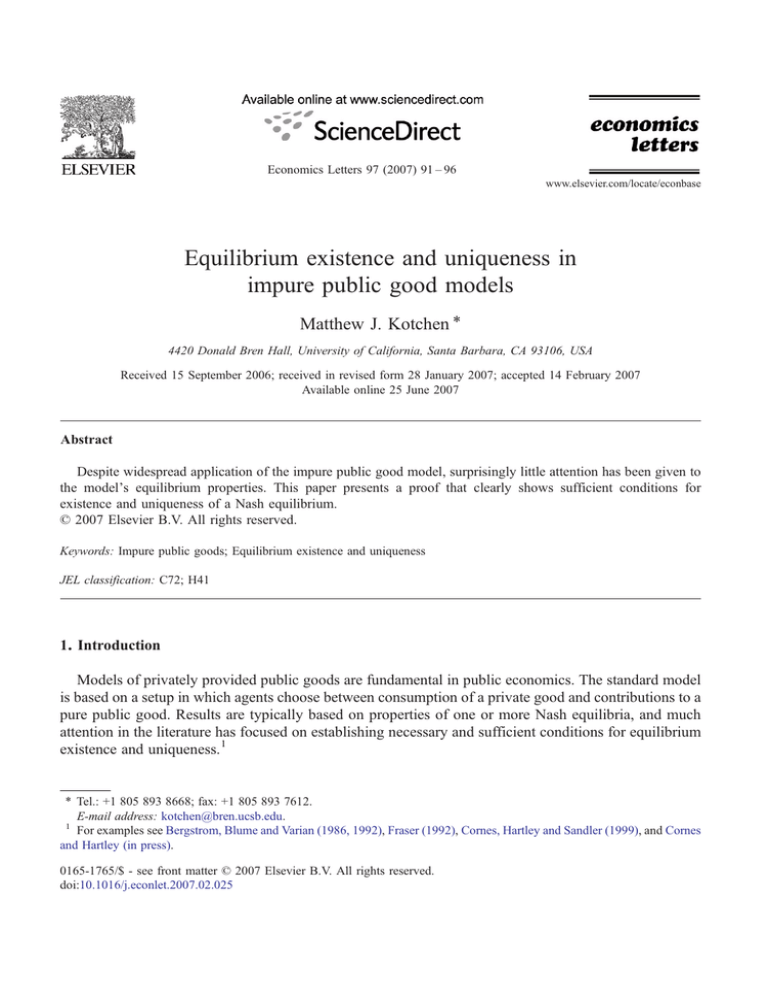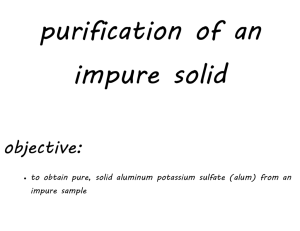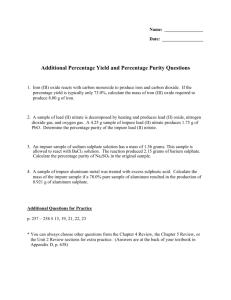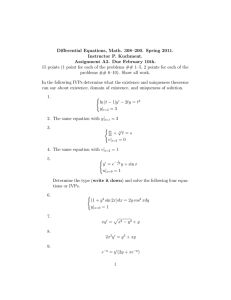Equilibrium existence and uniqueness in impure public good models Matthew J. Kotchen ⁎
advertisement

Economics Letters 97 (2007) 91 – 96
www.elsevier.com/locate/econbase
Equilibrium existence and uniqueness in
impure public good models
Matthew J. Kotchen ⁎
4420 Donald Bren Hall, University of California, Santa Barbara, CA 93106, USA
Received 15 September 2006; received in revised form 28 January 2007; accepted 14 February 2007
Available online 25 June 2007
Abstract
Despite widespread application of the impure public good model, surprisingly little attention has been given to
the model's equilibrium properties. This paper presents a proof that clearly shows sufficient conditions for
existence and uniqueness of a Nash equilibrium.
© 2007 Elsevier B.V. All rights reserved.
Keywords: Impure public goods; Equilibrium existence and uniqueness
JEL classification: C72; H41
1. Introduction
Models of privately provided public goods are fundamental in public economics. The standard model
is based on a setup in which agents choose between consumption of a private good and contributions to a
pure public good. Results are typically based on properties of one or more Nash equilibria, and much
attention in the literature has focused on establishing necessary and sufficient conditions for equilibrium
existence and uniqueness.1
⁎ Tel.: +1 805 893 8668; fax: +1 805 893 7612.
E-mail address: kotchen@bren.ucsb.edu.
1
For examples see Bergstrom, Blume and Varian (1986, 1992), Fraser (1992), Cornes, Hartley and Sandler (1999), and Cornes
and Hartley (in press).
0165-1765/$ - see front matter © 2007 Elsevier B.V. All rights reserved.
doi:10.1016/j.econlet.2007.02.025
92
M.J. Kotchen / Economics Letters 97 (2007) 91–96
The standard model is a special case of the impure public good model (Cornes and Sandler, 1984,
1994). The notion of an impure public good, which is based on joint production of private and public
characteristics, has been adapted to a wide variety of applications. Perhaps the most well-known is the
model of warm-glow giving (Andreoni, 1989, 1990). Other applications include the study of military
alliances (Sander and Murdoch, 1990), agricultural research (Khanna et al., 1994), household refuse
collection (Dubin and Navarro, 1988), pollution abatement (Rubbelke, 2003), and environmentally
friendly consumption (Kotchen, 2005).
Despite widespread use of the impure public good model, surprisingly little attention has been given to
questions about equilibrium existence and uniqueness. Relying on a proof for the pure public good model,
Cornes, Hartley and Sandler (1999) identify bounds on best-response functions that are sufficient for
equilibrium existence and uniqueness in the impure public good model. Nevertheless, they explain how
the conditions are not intuitive and are of little interest in relation to the typical normality assumption in
public goods models. Andreoni (1986) provides a proof for the model of warm-glow giving. While the
sufficient conditions are stated in terms of a normality assumption, existence and uniqueness are shown in
two different steps, and the analysis ignores the very real possibility for corner solutions in which some
individuals do not make a contribution.
Beyond these two studies, there has been no attempt in the literature to provide a general proof of
equilibrium existence and uniqueness for impure public good models. Most papers investigate the
comparative statics of individual behavior and thereby ignore the game theoretic features of the model.
This is a potentially important omission because many of the basic results for pure public goods do not
apply for impure public goods. Examples include the facts that neutrality of income redistributions need
not hold, Nash behavior does not necessarily result in suboptimal provision, and demand functions need
not conform to standard price and income relationships. 2 Thus, it is important that more careful attention
be given to equilibrium properties in impure public good models.
This paper provides a general proof of equilibrium existence and uniqueness. The approach extends
Cornes and Hartley's (in press) technique for analyzing aggregative public good games. The proof has
several advantages. First, it establishes existence and uniqueness in a single, straightforward step that
allows for possible corner solutions. Second, the sufficient conditions relate directly to standard normality
assumptions. Third, as described by Cornes and Hartley, an inherent advantage of the technique is the
nonproliferation of dimensions that comes with the typical approach of using fixed-point theorems.
Finally, the proof opens the door for nontrivial extensions of comparative static analysis of individual
behavior, as conducted in previous studies, to comparative static analysis of Nash equilibria.
2. The impure public good model
Individuals i = 1, …, n are assumed to derive utility from characteristics of goods rather than from
goods themselves. There are three characteristics–x, y and Z–where x and y have properties of a private
good and Z has properties of a pure public good. Individual preferences are given by a strictly increasing
n
zi = Z−i + zi.
and strictly quasiconcave utility function Ui = Ui (xi, yi, Z), where Z = ∑i=1
Characteristics are available through two consumption goods. The first good (a composite numeraire)
generates characteristic xi only, and assuming that the good and characteristic are measured in the same
units, the notation xi can be used to denote both. The second good, denoted qi, is an impure public good
2
See Cornes and Sandler (1984, 1994) for further discussion.
M.J. Kotchen / Economics Letters 97 (2007) 91–96
93
that generates yi and zi jointly. The technology of joint production is such that one unit of qi generates
β N 0 units of yi and γ N 0 units of zi.
Each individual's utility maximization problem can be written as
maxfUi ðxi ; yi ; ZÞj xi þ pqi ¼ wi ; yi ¼ bqi ; Z ¼ Z−i þ gqi g;
xi ;qi
ð1Þ
where p is the price of the impure public good. Specification of this maximization problem for all i
individuals establishes the setup of the standard impure public good model (Cornes and Sandler 1984,
1994).
We can further simplify the model by changing the units of q, y, and Z to normalize the exogenous
parameters p, β, and γ. First, choose units of the impure public good to normalize its price such that
gi = pqi denotes the rescaled good. Second, choose units of the jointly produced private characteristic such
that one unit of gi generates one unit of the characteristic, implying that gi can denote the quantity of the
impure public good and its private characteristic. Finally, choose units of the public characteristic such
that one unit of gi generates one unit of it as well, implying that gi can also denote the quantity of
n
gi = G−i + gi, the
individuals i's provision of the public good. Substituting gi into (1), and letting G = ∑i=1
utility maximization problem can be rewritten as
maxfui ðxi ; gi ; GÞj xi þ gi ¼ wi ; G ¼ G−i þ gi g;
xi ;gi
ð2Þ
where the rescaled utility function ui inherits the properties of being strictly increasing and strictly
quasiconcave.
Maximization problem (2) is identical to the setup of Andreoni's (1989, 1990) model of warm-glow
giving, in which individuals make donations for a combination of ‘egoistic’ and ‘altruistic’ reasons. Thus,
as the preceding steps make clear, the warm-glow and impure public good models are equivalent; the only
difference is the units of the impure public good and its associated characteristics. This equivalence has
yet to be shown formally in the literature, and as we will see, it is useful for proving existence and
uniqueness of a Nash equilibrium.
It is convenient to continue working with (2) rather than (1). Add G−i to both sides of the budget
constraint, substitute it into the objective function, and rewrite the individual's problem with a choice over
the aggregate level of the public good:
max ui ðwi þ G−i −G; G−G−i ; GÞ:
GzG−i
ð3Þ
The individual's optimal choice of G will be a continuous function of the exogenous portions of the
maximand: fi (wi + G− i, G− i) ≥ G− i.3 Each individual's level of private provision, or best-response
function, can then be written as
gi ¼ fi ðwi þ G−i ; G−i Þ−G−i z0:
3
Andreoni (1989, 1990) defines fi for only interior solutions, but it causes no trouble to let the function account for corner
solutions as well.
94
M.J. Kotchen / Economics Letters 97 (2007) 91–96
This expression shows that each individual either contributes a positive amount or completely free rides
and contributes zero.
Typically, in models of privately provided public goods, a further assumption is made that explicitly or
implicitly places bounds on best-response functions. Here the assumption is stated as follows:
The normality assumption 0bAfi =AG−i V1:
This requires that an increase in an individual's spillin, G− i, must increase her demand for the public
good and not decrease her demand for the private good. Equivalently, it requires that best-response
functions have slopes greater than −1 and less than or equal to zero. The assumption is referred to as the
normality assumption because the condition is satisfied if we simply assume that both the private and
public goods are normal with respect to “full income,” which includes personal income plus the value of
public good spillins (i.e., wi + G−sub i in this case). In other words, the assumption is satisfied if
preferences are such that the slope of the full-income Engel curve for G is everywhere within (0, 1].4
3. Equilibrium existence and uniqueness
Continuing to work with the simplified (warm-glow) formulation, a Nash equilibrium is a set of
n
n
contributions {g⁎i }i=1
that satisfies the aggregation rule G⁎ = ∑i=1
g ⁎i . This section proves existence and
uniqueness of a Nash equilibrium. The proof is an extension of Cornes and Hartley's (in press)
replacement function approach for analyzing aggregative public good games.
Suppress wi and define the function hi (G−i) = fi (wi + G−i, G−i). Furthermore, let Gi = hi (0) for all i,
which is the amount of public good that individual i would provide in the absence of any provision by
others. We can now define a replacement function for each individual and prove its important properties.
Lemma 1. There exists a well-defined and continuous function, ri(G), for all i that determines i's
contribution level as a function of any G ≥ Gi, and the function ri (G) satisfies ri (Gi ) = Gi and ri′(G) ≤ 0. 5
Proof. For G ≥ Gi define ri implicitly with hi (G − ri) − G ≡ 0. By the implicit function theorem, ri (G) is
a well-defined and continuous function. At interior solutions ri N 0, and at corner solutions ri = 0.
By definition ri (Gi) = Gi and riVðGÞ ¼ 1− hi1VðdÞ V0, where the inequality follows from the i normality
assumption.
□
n
. With G defining the lower bound of its domain, the aggregate
Now define G = max {Gi}i=1
replacement function and its properties follow directly from the individual replacement functions.
n
Lemma 2. There exists a function R (G) = ∑i=1
ri (G) that is defined for all G ≥ G, is continuous, and
satisfies R (G ) ≥ G and R′ (G) ≤ 0.
4
It is straightforward to show, following the same steps, that the normality assumption and its interpretation is the same even
in the more general formulation without the normalization of the exogenous parameters.
5
The function ri (G) is referred to as an individual's replacement function because it is consistent with the following thought
experiment: For any exogenous G within the permissible domain, there exists a unique quantity b ∈ [0, G] such that if b were
subtracted from G, the individual would choose to replace exactly the quantity removed, so that b = ri (G).
M.J. Kotchen / Economics Letters 97 (2007) 91–96
95
We can use the replacement functions to characterize a Nash equilibrium. For any level of aggregate
provision G that might arise, it must be true that gi = ri for all i. Hence a Nash equilibrium is a set of
n
that satisfies R (G⁎) = G⁎. With this definition, we can prove the main result.
replacement values {ri (G⁎)}i=1
Proposition 1. There exists a unique Nash Equilibrium.
Proof. It is sufficient to prove existence of a unique G⁎ that satisfies R (G⁎) = G⁎. We have shown that
R (G) is continuous, nonincreasing, and R ( G) ≥ G. Hence there exists a solution to R (G) = G, and it is
unique.
□
This proof establishes equilibrium existence and uniqueness in a single step. The approach clearly
demonstrates how the normality assumption is sufficient for uniqueness but not necessary for existence.
This follows because only continuity of R (G) is necessary for existence, but monotonicity, which is
implied by the normality assumption, is sufficient for uniqueness.
4. Conclusion
This paper provides a proof of equilibrium existence and uniqueness for the impure public good model.
The approach is to show equivalence between the impure public good model and the warm-glow model
and to prove the result for the latter. The proof underscores in a single, straightforward step how the
assumptions that are sufficient for existence and uniqueness in the impure public good model are not only
identical to those for the warm-glow model, but also those for the pure public good model. The results
should serve as a useful reference for future applications and extensions of the impure public good model.
As demonstrated in Kotchen (2006), application of the approach for analyzing impure public goods
provides a foundation for investigating new results involving comparative static analysis of Nash
equilibria. With changes in exogenous conditions, one needs only understand the effects on individual
replacement functions in order to understand the effects on equilibrium results.
Acknowledgments
I am grateful to Jim Andreoni and Richard Cornes for helpful comments on an earlier version of this
paper.
References
Andreoni, James, 1986. “Essays on Private Giving to Public Goods,” PhD Dissertation, Department of Economics, University of
Michigan, Ann Arbor.
Andreoni, James, 1989. Giving with impure altruism: applications to charity and Ricardian equivalence. Journal of Political
Economy 97, 1447–1458.
Andreoni, James, 1990. Impure altruism and donations to public goods: a theory of warm-glow giving. Economic Journal 100,
464–477.
Bergstrom, Theodore C., Blume, Lawrence E., Varian, Hal R., 1986. On the private provision of public goods. Journal of Public
Economics 29, 25–49.
Bergstrom, Theodore C., Blume, Lawrence E., Varian, Hal R., 1992. Uniqueness of Nash equilibrium in private provision of
public goods: an improved proof. Journal of Public Economics 49, 391–392.
Cornes, Richard, Roger Hartley, in press. “Aggregative Public Good Games,” Journal of Public Economic Theory.
96
M.J. Kotchen / Economics Letters 97 (2007) 91–96
Cornes, Richard, Sandler, Todd, 1984. Easy riders, joint production, and public goods. Economic Journal 94, 580–598.
Cornes, Richard, Sandler, Todd, 1994. The comparative static properties of the impure public good model. Journal of Public
Economics 54, 403–421.
Cornes, Richard, Hartley, Roger, Sandler, Todd, 1999. Equilibrium existence and uniqueness in public good models: an
elementary proof via contradiction. Journal of Public Economic Theory 1, 499–509.
Dubin, Jeffrey A., Navarro, Peter, 1988. How markets for impure public goods organize: the case of household refuse collection.
Journal of Law, Economics, and Organization 4, 217–241.
Fraser, Clive D., 1992. The uniqueness of Nash equilibrium in the private provision of public goods: an alternative proof. Journal
of Public Economics 49, 389–390.
Khanna, Jyoti, Huffman, Wallace E., Sandler, Todd, 1994. Agricultural research expenditures in the U.S.: a public goods
perspective. Review of Economics and Statistics 76, 267–277.
Kotchen, Matthew J., 2005. Impure public goods and the comparative statics of environmentally friendly consumption. Journal
of Environmental Economics and Management 49, 281–300.
Kotchen, Matthew J., 2006. Green markets and private provision of public goods. Journal of Political Economy 114, 816–834.
Rubbelke, Dirk T.G., 2003. An analysis of differing abatement incentives. Resource and Energy Economics 25, 269–294.
Sander, Todd, Murdoch, James C., 1990. Nash–Cournot or Lindahl behavior? An empirical test for the NATO allies. Quarterly
Journal of Economics 105, 875–894.






